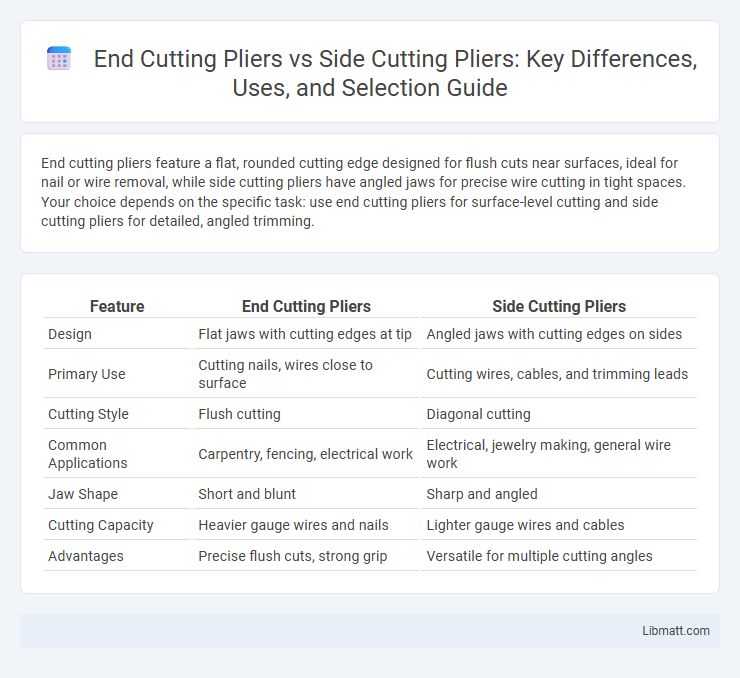End cutting pliers feature a flat, rounded cutting edge designed for flush cuts near surfaces, ideal for nail or wire removal, while side cutting pliers have angled jaws for precise wire cutting in tight spaces. Your choice depends on the specific task: use end cutting pliers for surface-level cutting and side cutting pliers for detailed, angled trimming.
Table of Comparison
| Feature | End Cutting Pliers | Side Cutting Pliers |
|---|---|---|
| Design | Flat jaws with cutting edges at tip | Angled jaws with cutting edges on sides |
| Primary Use | Cutting nails, wires close to surface | Cutting wires, cables, and trimming leads |
| Cutting Style | Flush cutting | Diagonal cutting |
| Common Applications | Carpentry, fencing, electrical work | Electrical, jewelry making, general wire work |
| Jaw Shape | Short and blunt | Sharp and angled |
| Cutting Capacity | Heavier gauge wires and nails | Lighter gauge wires and cables |
| Advantages | Precise flush cuts, strong grip | Versatile for multiple cutting angles |
Introduction to Cutting Pliers
End cutting pliers feature a cutting edge at the tip, designed for flush cutting wires, nails, and bolts close to surfaces, making them ideal for precision tasks in electrical and construction work. Side cutting pliers, also known as diagonal pliers, have blades set at an angle on the jaws, optimized for cutting wire, cables, and small pins efficiently while gripping the material securely. Both tools are essential in various industries, with their specific cutting angles and jaw designs tailored to distinct applications and material types.
What Are End Cutting Pliers?
End cutting pliers feature a cutting edge located at the tip of the tool, designed primarily for cutting nails, wires, and bolts close to the surface without damaging the surrounding material. These pliers provide leverage and precision for tasks such as trimming excess wire in electrical work or removing stubborn nails in woodworking. Understanding the specific function of end cutting pliers can improve the efficiency and safety of your projects where precise, flush cuts are essential.
What Are Side Cutting Pliers?
Side cutting pliers feature sharp, angled jaws designed for cutting wire close to the surface, making them essential for electrical work and precision tasks. Their cutting edges align with the handles, allowing for easy flush cuts on nails, wires, and pins without damaging surrounding material. Unlike end cutting pliers, side cutters excel in trimming and snipping rather than pulling or removing fasteners.
Key Design Differences
End cutting pliers feature jaws that meet at the tip, allowing for flush cutting close to surfaces, which is ideal for tasks like nail pulling and wire trimming. Side cutting pliers have jaws positioned on the side, enabling cutting along the length of a wire without surface damage, commonly used in electrical work. The distinct jaw orientation directly influences the cutting approach and application efficiency for each plier type.
Typical Uses for End Cutting Pliers
End cutting pliers are primarily used for cutting through nails, wires, and staples close to the surface, making them essential for tasks in construction, carpentry, and demolition. Their design allows for flush cuts, which is especially useful when removing fasteners without damaging surrounding material. These pliers offer strong leverage and precision in trimming and pulling applications where side clearance is limited.
Typical Uses for Side Cutting Pliers
Side cutting pliers are primarily used for cutting wires, trimming nails, and snipping small metal components in electrical and jewelry work. Their angled cutting edges allow close, flush cuts on materials like copper, brass, and aluminum, making them ideal for precision tasks. Unlike end cutting pliers, side cutters excel at reaching tight spots and making clean cuts without damaging adjacent surfaces.
Advantages and Disadvantages
End cutting pliers offer precision and leverage for cutting nails and wires flush with surfaces, minimizing damage to surrounding materials. Side cutting pliers provide versatility for cutting and gripping wires at various angles but may lack the flush cutting ability of end cutting pliers. Your choice depends on whether you prioritize clean cuts close to surfaces or multifunctional wire manipulation.
Choosing the Right Pliers for Your Task
End cutting pliers are designed for cutting nails, wires, and other materials flush with a surface, making them ideal for demolition and finishing tasks. Side cutting pliers, also known as diagonal cutters, excel at cutting wire and small pins in tight spaces due to their angled cutting edges. Choosing the right pliers depends on your specific task requirements, ensuring precise and efficient results with minimal effort.
Safety Tips for Using Cutting Pliers
When using end cutting pliers and side cutting pliers, always wear safety glasses to protect your eyes from flying debris. Keep cutting edges sharp and free of rust to ensure clean cuts and reduce slippage risks. Apply steady pressure and avoid twisting motions to prevent tool damage and potential hand injuries.
Conclusion: Which Pliers Should You Choose?
End cutting pliers excel in cutting nails, wires, and bolts flush with surfaces, making them ideal for demolition and construction tasks requiring precision cutting close to the base. Side cutting pliers, also known as diagonal pliers, are versatile tools designed for trimming, gripping, and bending wires, commonly used in electrical work and general-purpose cutting. Choose end cutting pliers for flush cuts and tougher materials, while side cutting pliers suit detailed wire work and lighter cutting needs.
End cutting pliers vs side cutting pliers Infographic

 libmatt.com
libmatt.com